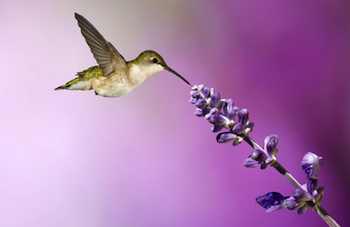By Sean Conway

A hummingbird feeding on nectar from salvia flowers. Salvia is one of several late-blooming plants that attract hummingbirds on their annual migration southward in late summer and early fall.
Gardeners aren't the only ones who enjoy summer's last gasp; well-planted gardens are favorite spots for migrating hummingbirds.
Fall is the perfect time to enjoy these winged wonders. As days shorten and nights begin to cool, hummingbirds begin their yearly trek south from their summer breeding grounds in the northern half of the country to the warmer regions of Mexico and Central America. Attracting these fascinating birds to your garden isn't difficult.
Flowering plants, selected for their nectar-rich blossoms provide hummingbirds with much needed fuel for their long arduous trip, and including a few in your garden is a sure-fire way to encourage them for a quick pit-stop.
Hummingbirds are constantly on the move in search of food. They prefer high-octane meals to fuel their fast metabolisms. Their food of choice is the calorie-rich nectar found in flowers. Tubular shaped flowers often contain larger amounts of nectar than flat or shallow shaped flowers, and so the birds tend to prefer them.
Salvias, often grown for their abundance of vibrantly colored fall flowers, are one of the best nectar sources for hummingbirds. There are a variety of garden-worthy salvias, and the majority of them bloom best in the short days of late summer and early fall, which is just when hummingbirds are passing through.
Planting flowering shrubs in your garden is another way of enticing hummingbirds to visit. The advantage of planting flowering shrubs is that, once planted, they will bloom year after year with little more than an occasional pruning to maintain their shape.
Fall is an excellent time to plant perennials and shrubs. Both will establish quickly, as air temperatures moderate, provided there is an adequate amount of moisture in the soil. Soil temperatures remain relatively warm well into the fall, which encourages root formation. If possible, allow plants four to six weeks' time to establish themselves before frost arrives in your area. Gardeners in Southern states enjoy a longer fall planting window than those in the North.
Many of these shrubs can be grown in patio containers to bring hummingbirds closer to your back door. Here are Tim's suggestions of container-worthy shrubs that attract hummingbirds:
Abelia chinensis
Abelia mosanensis
Buddleia davidii 'Nanho Purple'
Buddleia 'Lo and Behold'
Clethra 'Hummingbird'
Hibiscus 'Blue Chiffon,' 'Lavender Chiffon' or 'White Chiffon'
Kolkwitzia 'Pink Cloud'
Vitex agnus-castus
Weigela 'Ghost' or 'Wine and Roses'
As summer winds down and the days shorten be sure to keep an eye out for visiting hummingbirds. With a little thought and some careful planning you can encourage them to stop in your garden instead of passing right by.
Available at Amazon.com:
Trowel and Error: Over 700 Tips, Remedies and Shortcuts for the Gardener
Cut Your Energy Bills Now: 150 Smart Ways to Save Money & Make Your Home More Comfortable & Green
It's Easy Being Green: A Handbook for Earth-Friendly Living
Copyright © Cultivating Life by Sean Conway. All rights reserved.
AUTOS | HOBBIES | EDUCATION | FAMILY | FASHION | FOOD & RECIPES | HOME DECOR | RELATIONSHIPS | PARENTING | PETS | TRAVEL | WOMEN
Home & Garden - Make Your Garden a Late Summer Pit Stop for Migratory Hummingbirds